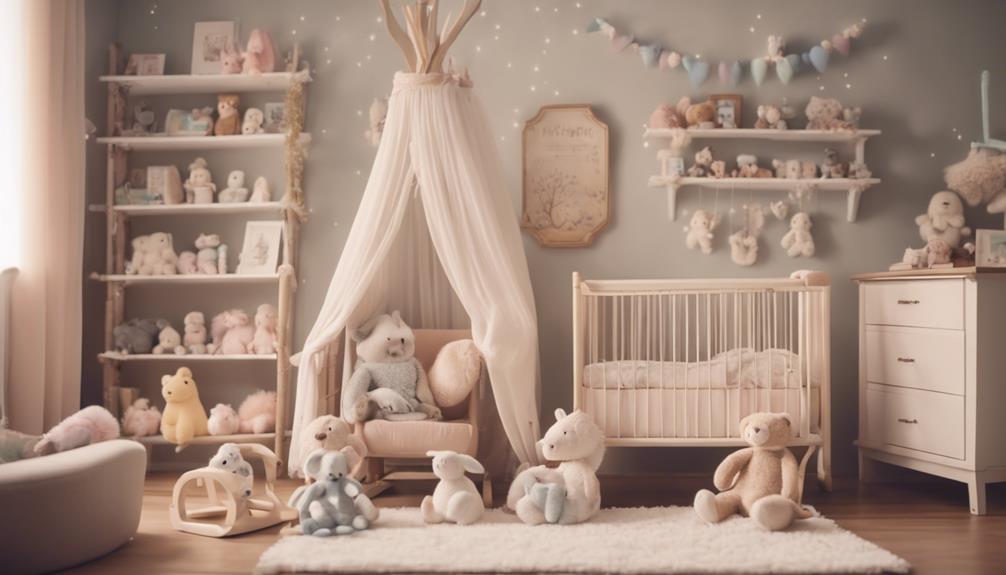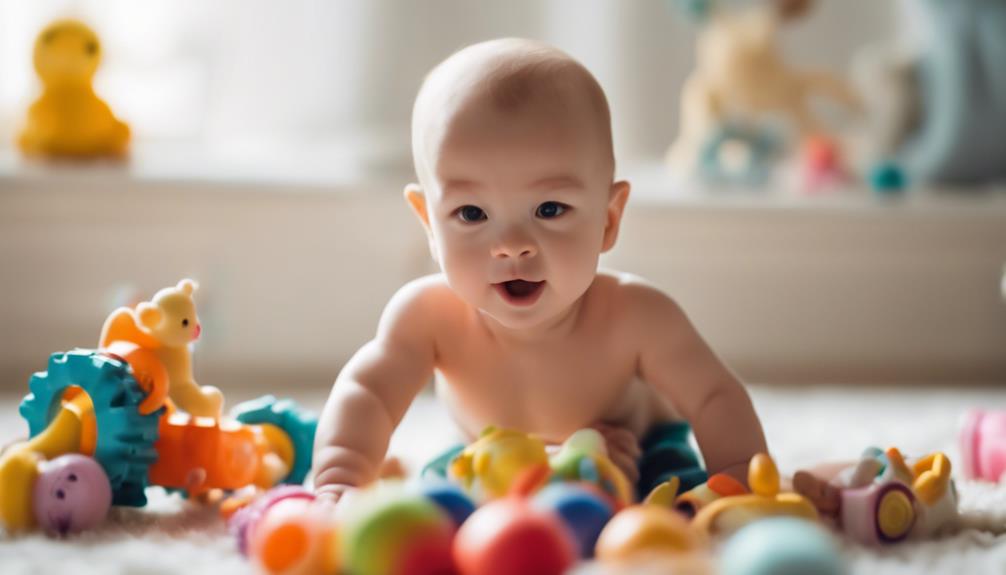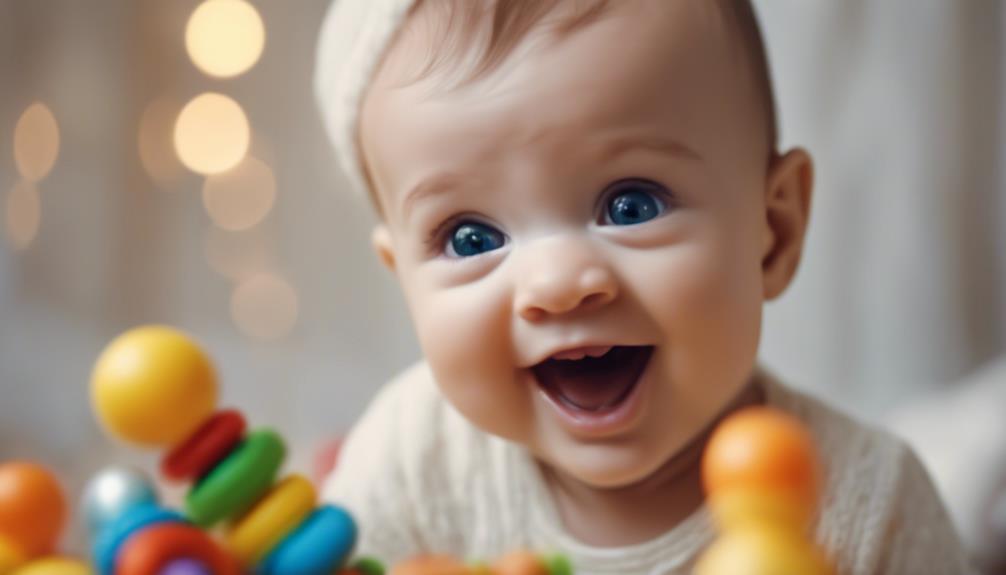To ensure happiness for your new baby right from the start, establish a consistent routine with regular feeding, sleeping, and playtimes. Respond promptly to their hunger and comfort signals to meet their needs. Create a safe environment by following safe sleep practices and babyproofing. Utilize soothing techniques like swaddling and white noise for relaxation. Invest in high-quality swaddling blankets that are made of breathable fabric. Integrate calming sounds like white noise and pacifiers to improve sleep. By following these tips, your newborn will feel safe and happy. More tips on newborn care are available for you to explore.
Key Takeaways
- Establish a consistent routine for feeding, sleeping, and playtime.
- Respond promptly to your baby's needs for feeding, comfort, and sleep.
- Create a secure environment with safe sleep practices and babyproofing.
- Use soothing techniques like swaddling, white noise, and rocking motions.
- Invest in quality swaddling blankets and calming sounds for a peaceful environment.
Establishing a Predictable Routine
Start by consistently setting up a predictable routine for your newborn baby to establish a sense of security and promote healthy sleep habits. Babies thrive on routine as it helps them feel secure and reduces stress. By establishing a consistent schedule for feeding, sleeping, and playtime, you can create a comforting environment for your little one.
Predictable routines not only assist in meeting your baby's needs effectively but also aid in developing healthy habits and fostering stability.
When you establish a routine, your baby knows what to expect, which can lead to better sleep patterns and overall well-being. By following a predictable schedule, you can anticipate when your baby needs to eat, sleep, or play, making it easier to provide the necessary care promptly.
This sense of predictability can create a comforting and secure environment that promotes a healthy bond between you and your newborn. Remember, consistency is key when it comes to setting up a routine that works for both you and your baby.
Meeting Their Needs Consistently

To secure your newborn's happiness, focus on meeting their needs consistently. Establishing a feeding schedule that aligns with their hunger cues, understanding their comforting signals, and creating a bedtime routine will foster a sense of security and well-being.
Feeding Schedule Consistency
Establishing a consistent feeding schedule for your newborn is crucial in meeting their needs consistently. Here are some tips to help you maintain a reliable routine for feeding your baby:
- Timing is Key: Feed your baby every 2-3 hours to guarantee they're receiving enough nutrition throughout the day.
- Respond to Hunger Cues: Pay attention to your baby's signals of hunger, such as rooting or sucking on their hands, and feed them promptly to keep them satisfied.
- Routine Builds Security: Consistency in feeding times helps your baby feel secure and establishes a sense of predictability in their day.
- Promote Digestive Health: Regular feeding intervals support healthy digestion and aid in your baby's growth and development.
Comforting Cues Understanding
Understanding your newborn's comforting cues is essential in consistently meeting their needs and fostering a strong sense of security. Respond promptly to cues like crying, rooting, or sucking, as these are their ways of communicating with you.
Providing comfort through techniques like swaddling, gentle rocking, and skin-to-skin contact can help your baby feel safe and secure in their new environment. Remember, newborns rely on you to regulate their emotions and create a soothing atmosphere. Maintain a calm environment with dim lighting, soft sounds, and a warm temperature for your little one.
Consistently attending to your baby's needs not only addresses their immediate comfort but also helps build trust, security, and a strong bond between you both right from the start. By recognizing and responding to their comforting cues, you're showing your baby that you're there for them, which is essential for their emotional development and overall well-being.
Sleep Routine Establishment
Consistently meeting your newborn's sleep needs is crucial for establishing a healthy sleep routine and promoting their overall well-being. To guarantee your baby gets the rest they need, follow these tips:
- Establish a consistent sleep routine: Setting regular bedtimes and nap times can help regulate your baby's internal clock, making it easier for them to fall asleep and wake up at the right times.
- Meet your baby's sleep needs promptly: Responding promptly to your baby's cues for sleep, such as rubbing their eyes or becoming fussy, can prevent overtiredness and promote healthy development.
- Create a calm and soothing bedtime environment: Dim the lights, play soft music, and engage in relaxing activities before bedtime to help your newborn relax and drift off to sleep peacefully.
- Ensure a safe sleep environment: Keep your baby's sleep area free from hazards, such as loose bedding or toys, to promote safe and restful sleep throughout the night.
Creating a Secure Environment
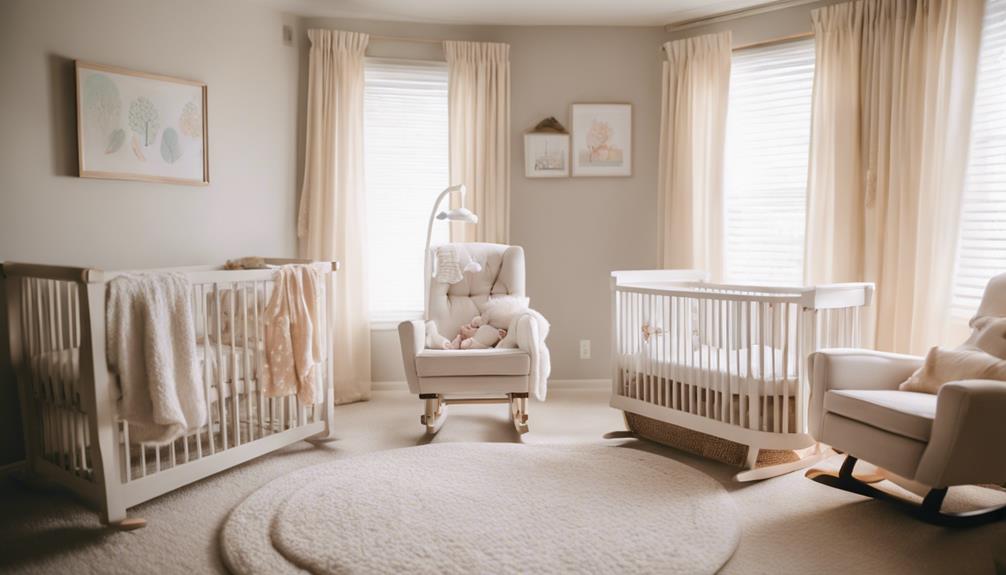
To establish a secure environment for your newborn, guarantee safe sleep practices by placing them on their back in a crib with no loose bedding.
Babyproof the house by securing cabinets and outlets, and have all feeding essentials easily accessible in a cozy feeding area.
Providing a comfortable, safe space for your baby will help promote their well-being and create a sense of security from the very beginning.
Safe Sleep Practices
Establishing a secure sleep environment for your newborn is crucial to guaranteeing their safety and well-being from the very start. Follow these safe sleep practices to help your baby rest peacefully:
- Back to Sleep: Always place your baby on their back to sleep in a crib with a firm mattress. This position reduces the risk of Sudden Infant Death Syndrome (SIDS) and promotes your baby's development.
- No Loose Items: Keep soft objects, loose bedding, and toys out of the crib to create a safe sleeping space for your little one. These items can pose suffocation hazards.
- Maintain Temperature: Maintain a comfortable room temperature between 68-72°F to prevent your baby from overheating during sleep. This temperature range ensures a cozy and safe sleep environment.
- Use a Pacifier: Consider offering a pacifier at naptime and bedtime to help reduce the risk of SIDS. However, wait until breastfeeding is established before introducing it.
Babyproofing Essentials
Safeguard your newborn's safety and well-being by implementing essential babyproofing measures to create a secure environment in your home. As babies develop quickly, it's important to prioritize their safety by childproofing your living spaces. Here are some key babyproofing essentials to take into account:
| Babyproofing Essentials | Description |
|---|---|
| Safety Gates | Install at stairways and doorways to prevent falls. |
| Outlet Covers | Cover electrical outlets to avoid shocks. |
| Cabinet Locks | Secure cabinets to keep harmful items out of reach. |
| Furniture Anchors | Prevent tip-overs by securing heavy furniture. |
| Corner Guards | Cover sharp edges to avoid injuries. |
Ensuring your child feels safe in their surroundings is essential for their well-being. By taking these precautions, you can create a secure environment that allows your baby to explore and learn without unnecessary risks. Remember, constant supervision is key to maintaining a safe space for your little one.
Comfortable Feeding Areas
Create a secure and comfortable feeding area in your home for your newborn by designating a quiet and cozy corner. To guarantee a soothing environment for both you and your baby during feeding sessions, follow these tips:
- Choose the Right Chair: Use a comfortable chair with good back support and armrests to prevent discomfort during long nursing or bottle-feeding sessions.
- Lighting Matters: Make sure to have good lighting in the feeding area for late-night feedings. Creating a soothing ambiance can promote relaxation for you and your baby.
- Keep Supplies Handy: Keep essential feeding supplies like burp cloths, bibs, and nursing pillows within reach. This will streamline the feeding process and minimize disruptions.
- Add Calming Elements: Consider adding calming elements such as soft music or a white noise machine to the feeding area. This can help your newborn relax and enjoy feeding time better.
Taking care of the feeding environment will make feeding time a more pleasant experience for both you and your little one.
Utilizing Soothing Techniques

To guarantee your newborn's comfort and well-being, incorporating soothing techniques can be highly beneficial in promoting relaxation and security. Helping your baby's first experiences be calming sets a positive tone for their development. Here are some effective techniques to help your baby relax:
| Technique | Description | Benefits |
|---|---|---|
| Swaddling | Wrapping your baby snugly in a blanket mimics the womb's comforting environment. | Promotes relaxation and security. |
| White Noise Machines | Background noise blocks out sudden sounds, creating a familiar and soothing environment. | Helps soothe newborns. |
| Pacifiers | Sucking on a pacifier triggers the calming reflex in babies, reducing stress and promoting relaxation. | Aids in calming and comforting newborns. |
| Swinging or Rocking Motions | Mimic soothing movements experienced in the womb, promoting relaxation. | Helps babies feel secure. |
| Shushing Sounds | Replicates familiar sounds heard in the womb, aiding in calming and comforting newborns. | Promotes relaxation and reduces stress. |
Investing in Swaddling Blankets
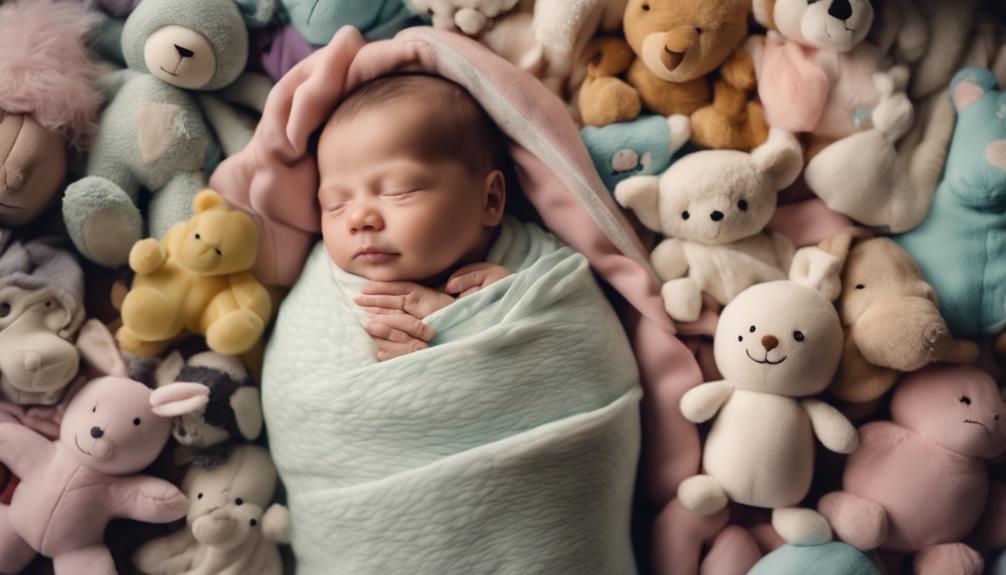
Consider investing in high-quality swaddling blankets to provide your newborn with comfort and security similar to the womb environment. Swaddling blankets play an important role in helping newborn babies adjust to the outside world by offering a sense of familiarity and warmth.
Here are some tips to guide you in selecting the perfect swaddling blankets for your little one:
- Opt for breathable fabrics to prevent overheating and guarantee your baby stays comfortable throughout the day and night.
- Look for swaddling blankets with secure closures to keep your baby snugly wrapped without the risk of unraveling during sleep.
- Choose swaddling blankets that are easy to clean and maintain, considering the frequent use and inevitable spills common with newborns.
- Consider investing in a few extra swaddling blankets to have backups ready in case of unexpected messes or laundry delays.
Investing in quality swaddling blankets can contribute to a peaceful and cozy environment for your newborn baby, promoting better sleep and overall well-being.
Incorporating Calming Sounds
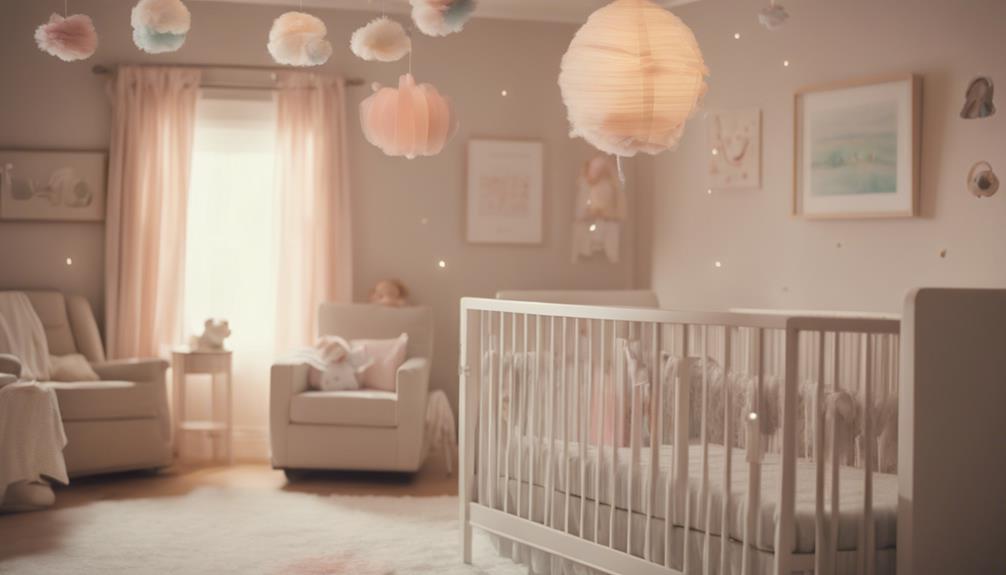
Enhance your newborn's environment by incorporating calming sounds like white noise or shushing to trigger a calming reflex and promote comfort and security.
Calming sounds have been shown to help newborns relax, especially when combined with swaddling blankets. Swaddling your baby snugly in a soft, secure blanket can mimic the feeling of being in the womb, providing a sense of safety and warmth. Investing in quality swaddling blankets for the first few months can aid in calming your newborn and encouraging better sleep patterns.
Additionally, using white noise machines that emit soothing sounds, such as high or low-pitched tones, can further help calm fussy babies. Sucking on pacifiers or employing other soothing techniques can also contribute to your newborn feeling relaxed and content.
Frequently Asked Questions
What to Do With a Newborn Day 1?
On day one with a newborn, focus on skin-to-skin contact, initiate breastfeeding within the first hour, create a calm environment, schedule a doctor's visit, and be attentive to cues for feeding, diaper changes, and sleep.
How Do You Express Happiness for a New Newborn?
Express happiness for a new newborn by showering them with affection, cuddles, and gentle touches to create a bond from the beginning. Use positive facial expressions, soothing tones, and gentle movements to convey joy and warmth towards the newborn.
How to Enjoy the Newborn Stage More?
To enjoy the newborn stage more, engage in skin-to-skin contact for bonding, try baby massage for relaxation, prioritize self-care for presence, capture moments for memories, and seek support for shared joy. Embrace these practices to savor each precious moment.
How Do I Settle My 1 Day Old Baby?
To settle your 1-day-old baby, swaddle them snugly, rock gently, provide skin-to-skin contact for warmth and bonding, feed frequently, and maintain a calm, quiet, dimly lit environment to promote relaxation and sleep.
Conclusion
To sum up, ensuring a happy newborn baby from day one may seem like a challenging task, but with the right techniques and tools, it can be a breeze.
Remember, babies thrive on routine, consistency, and security. So, go ahead and invest in those swaddling blankets, play those calming sounds, and create a soothing environment.
Before you know it, you'll have a little bundle of joy who's as content as can be. Happy parenting!

